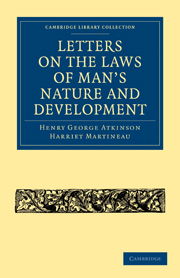Book contents
- Frontmatter
- Preface
- Mottoes
- Contents
- Letter. 1 Inquiry for a Basis
- Letter. 2 Proposal of a Basis
- Letter. 3 Preparation of the Ground
- Letter. 4 What is the Brain?
- Letter. 5 Inquiry about its Structure
- Letter. 6 Early days of Phrenology
- Letter. 7 Inquiry for New Discoveries
- Letter. 8 Methods of New Discovery. Organic Arrangement of the Brain
- Letter. 9 Illustrative Cases
- Letter. 10 Organic Arrangement of the Cerebrum
- Letter. 11 Dr. Howe's Report on Idiocy
- Letter. 12 The Senses and Nervous System
- Letter. 13 Illustrative Comment
- Letter. 14 Facts about the Senses under various conditions
- Letter. 15 Raising questions
- Letter. 16 Bacon, on Matter and Causation. Inferences and Dreams. Association of Ideas
- Letter. 17 Nothing
- Letter. 18 Knowledge and Notions. Results of each
- Letter. 19 Release from Notions. Entrance upon Knowledge
- Letter. 20 Natural History of Superstition
- Letter. 21 Theology and Science
- Letter. 22 Central Law and Pervasive Unity. Light. Sense of Identity. Ghost-seeing. Unrevealed Human Relations
- Letter. 23 Position and Privilege of Truth-seekers
- Letter. 24 Position and Privilege of Truth-speakers
- Appendix
Letter. 5 - Inquiry about its Structure
Published online by Cambridge University Press: 29 August 2010
- Frontmatter
- Preface
- Mottoes
- Contents
- Letter. 1 Inquiry for a Basis
- Letter. 2 Proposal of a Basis
- Letter. 3 Preparation of the Ground
- Letter. 4 What is the Brain?
- Letter. 5 Inquiry about its Structure
- Letter. 6 Early days of Phrenology
- Letter. 7 Inquiry for New Discoveries
- Letter. 8 Methods of New Discovery. Organic Arrangement of the Brain
- Letter. 9 Illustrative Cases
- Letter. 10 Organic Arrangement of the Cerebrum
- Letter. 11 Dr. Howe's Report on Idiocy
- Letter. 12 The Senses and Nervous System
- Letter. 13 Illustrative Comment
- Letter. 14 Facts about the Senses under various conditions
- Letter. 15 Raising questions
- Letter. 16 Bacon, on Matter and Causation. Inferences and Dreams. Association of Ideas
- Letter. 17 Nothing
- Letter. 18 Knowledge and Notions. Results of each
- Letter. 19 Release from Notions. Entrance upon Knowledge
- Letter. 20 Natural History of Superstition
- Letter. 21 Theology and Science
- Letter. 22 Central Law and Pervasive Unity. Light. Sense of Identity. Ghost-seeing. Unrevealed Human Relations
- Letter. 23 Position and Privilege of Truth-seekers
- Letter. 24 Position and Privilege of Truth-speakers
- Appendix
Summary
H. M. to H. G. A.
We are coming to the pith of the matter now. When people speak of the brain as “the instrument of the mind,” I want them to tell me whether they think the dog, and the bee, and the ape, have each a mind which puts the brain in operation: and if so, whence it came, and whither it goes. You remember Scott's dog, which somehow attacked or alarmed a certain baker; and how this dog slunk into a corner whenever his master spoke of the adventure, whatever might be the tone of voice or the artifice with which the story was introduced; and how, when the upshot was told,—“and the baker was not hurt after all,”—the dog came out of his corner, frisking and joyful, and barking merrily. Now, this creature evidently felt shame and fear, and consciousness of self, relief and joy. And, again, when the monkey puts the wig into the boiler, and hides the plum-pudding, and then gets out of reach of punishment, as soon as any one goes near the boiler,—here is an exercise of several faculties, besides the most prominent ones of imitation and consciousness of self. Will any one say that these creatures have a separate mind, which uses the brain as a manifesting instrument? If so, what is the evidence? and how do we know that these animals are not of a nature equal to man, but furnished with a smaller apparatus of brain?
- Type
- Chapter
- Information
- Letters on the Laws of Man's Nature and Development , pp. 25 - 28Publisher: Cambridge University PressPrint publication year: 2009First published in: 1851

